Corporate Business Accounting Report
VerifiedAdded on 2022/09/01
|13
|3948
|19
AI Summary
Contribute Materials
Your contribution can guide someone’s learning journey. Share your
documents today.
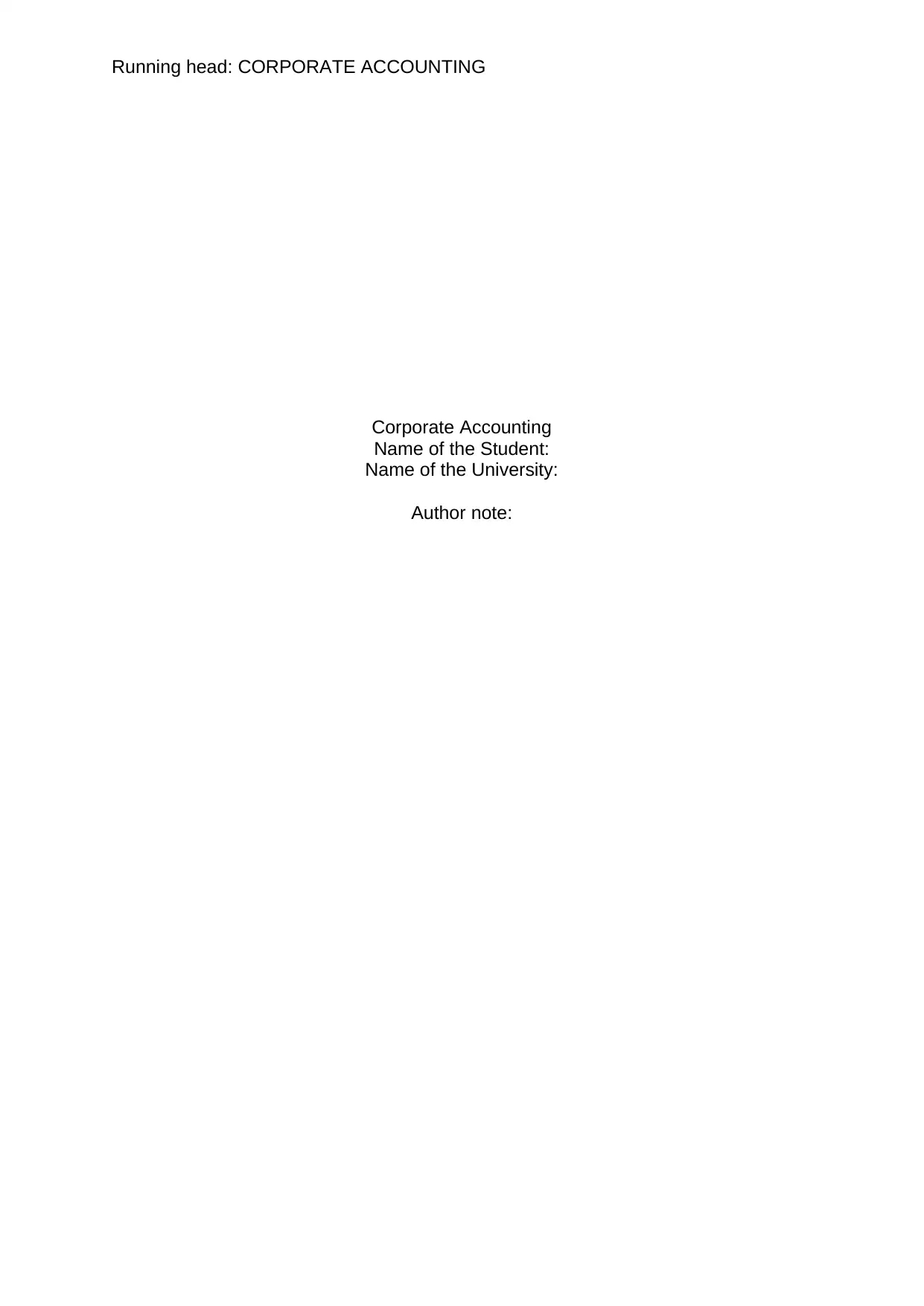
Running head: CORPORATE ACCOUNTING
Corporate Accounting
Name of the Student:
Name of the University:
Author note:
Corporate Accounting
Name of the Student:
Name of the University:
Author note:
Secure Best Marks with AI Grader
Need help grading? Try our AI Grader for instant feedback on your assignments.
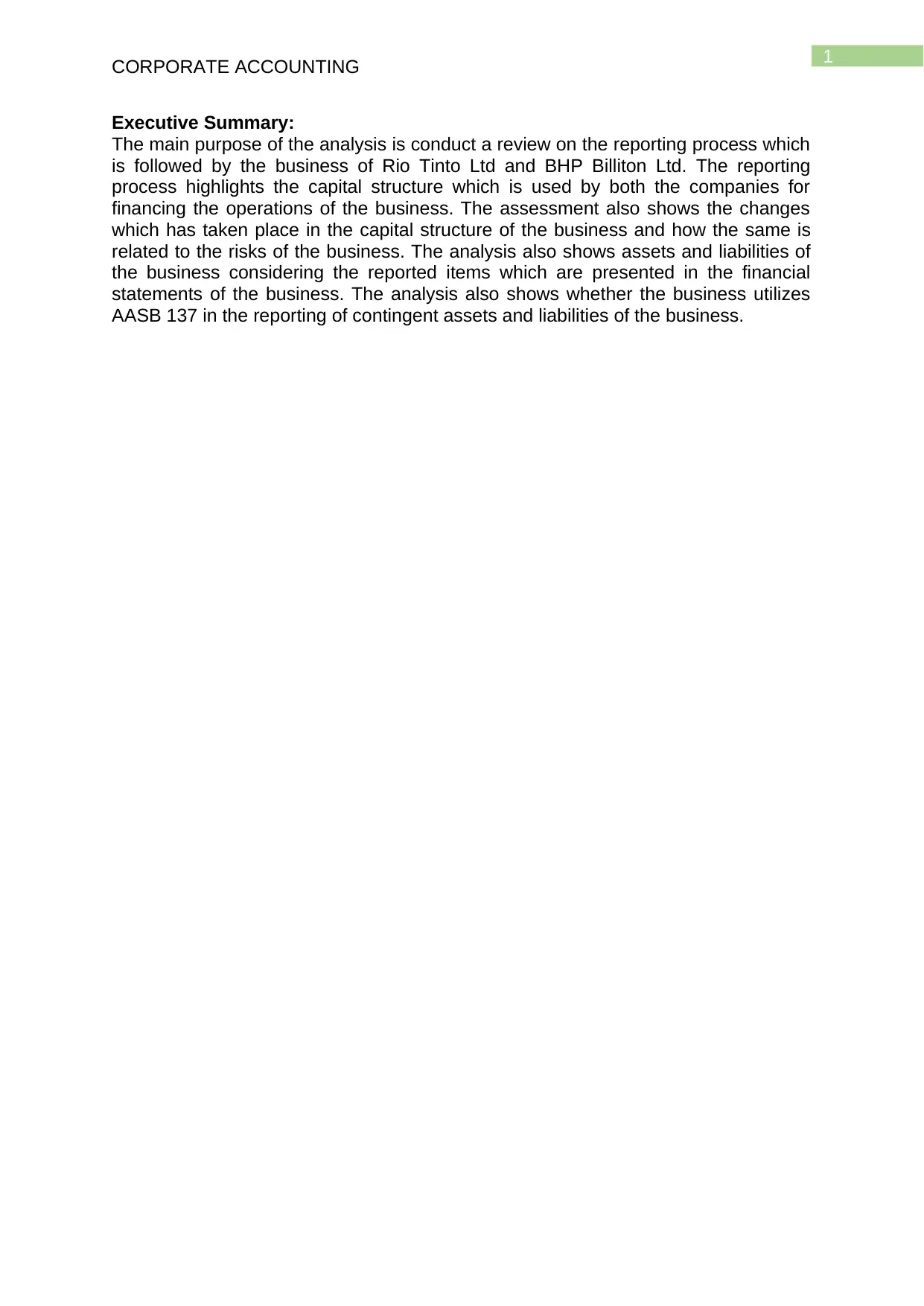
1
CORPORATE ACCOUNTING
Executive Summary:
The main purpose of the analysis is conduct a review on the reporting process which
is followed by the business of Rio Tinto Ltd and BHP Billiton Ltd. The reporting
process highlights the capital structure which is used by both the companies for
financing the operations of the business. The assessment also shows the changes
which has taken place in the capital structure of the business and how the same is
related to the risks of the business. The analysis also shows assets and liabilities of
the business considering the reported items which are presented in the financial
statements of the business. The analysis also shows whether the business utilizes
AASB 137 in the reporting of contingent assets and liabilities of the business.
CORPORATE ACCOUNTING
Executive Summary:
The main purpose of the analysis is conduct a review on the reporting process which
is followed by the business of Rio Tinto Ltd and BHP Billiton Ltd. The reporting
process highlights the capital structure which is used by both the companies for
financing the operations of the business. The assessment also shows the changes
which has taken place in the capital structure of the business and how the same is
related to the risks of the business. The analysis also shows assets and liabilities of
the business considering the reported items which are presented in the financial
statements of the business. The analysis also shows whether the business utilizes
AASB 137 in the reporting of contingent assets and liabilities of the business.
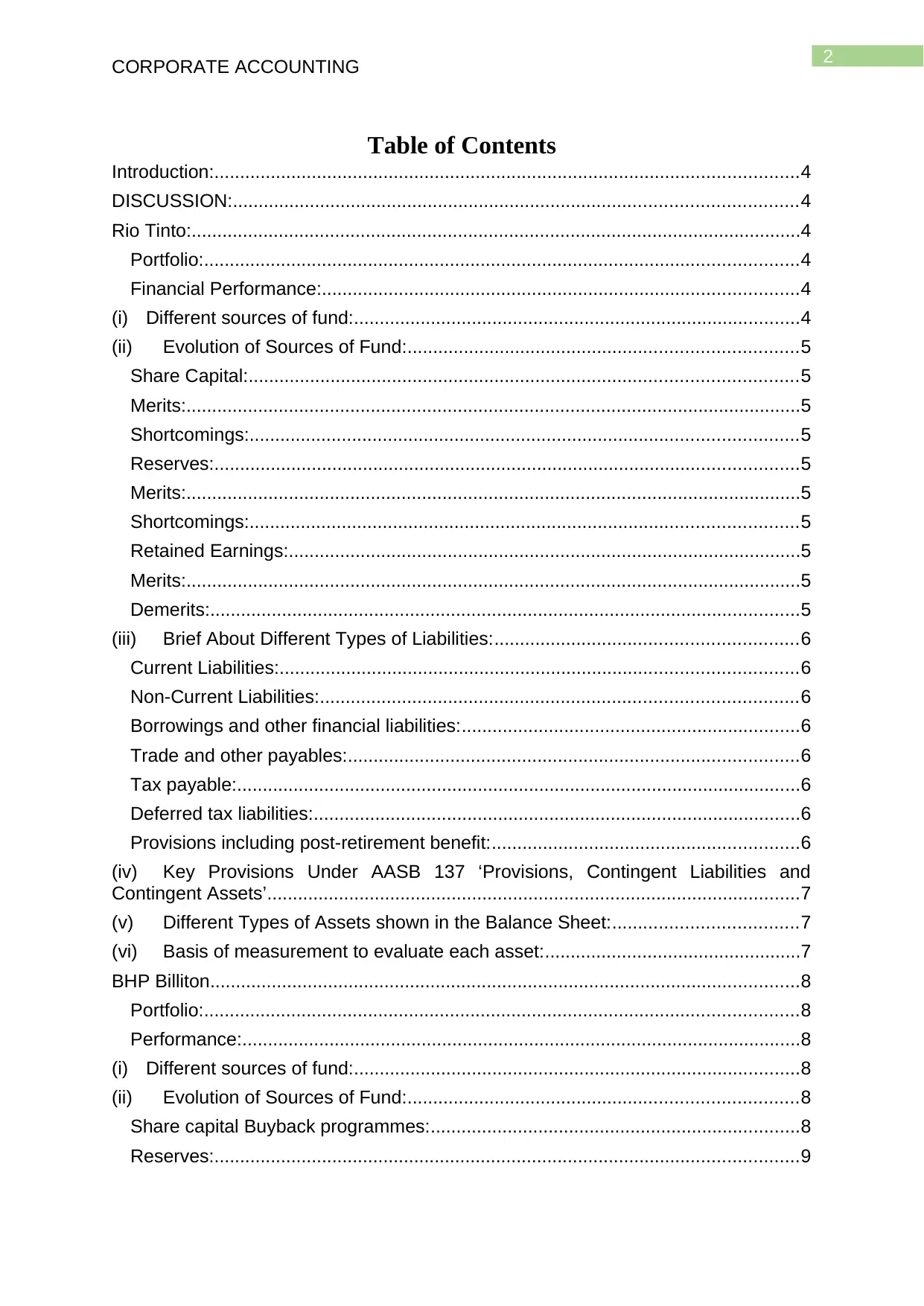
2
CORPORATE ACCOUNTING
Table of Contents
Introduction:..................................................................................................................4
DISCUSSION:..............................................................................................................4
Rio Tinto:.......................................................................................................................4
Portfolio:....................................................................................................................4
Financial Performance:.............................................................................................4
(i) Different sources of fund:.......................................................................................4
(ii) Evolution of Sources of Fund:............................................................................5
Share Capital:...........................................................................................................5
Merits:........................................................................................................................5
Shortcomings:...........................................................................................................5
Reserves:..................................................................................................................5
Merits:........................................................................................................................5
Shortcomings:...........................................................................................................5
Retained Earnings:....................................................................................................5
Merits:........................................................................................................................5
Demerits:...................................................................................................................5
(iii) Brief About Different Types of Liabilities:...........................................................6
Current Liabilities:.....................................................................................................6
Non-Current Liabilities:.............................................................................................6
Borrowings and other financial liabilities:..................................................................6
Trade and other payables:........................................................................................6
Tax payable:..............................................................................................................6
Deferred tax liabilities:...............................................................................................6
Provisions including post-retirement benefit:............................................................6
(iv) Key Provisions Under AASB 137 ‘Provisions, Contingent Liabilities and
Contingent Assets’........................................................................................................7
(v) Different Types of Assets shown in the Balance Sheet:....................................7
(vi) Basis of measurement to evaluate each asset:..................................................7
BHP Billiton...................................................................................................................8
Portfolio:....................................................................................................................8
Performance:.............................................................................................................8
(i) Different sources of fund:.......................................................................................8
(ii) Evolution of Sources of Fund:............................................................................8
Share capital Buyback programmes:........................................................................8
Reserves:..................................................................................................................9
CORPORATE ACCOUNTING
Table of Contents
Introduction:..................................................................................................................4
DISCUSSION:..............................................................................................................4
Rio Tinto:.......................................................................................................................4
Portfolio:....................................................................................................................4
Financial Performance:.............................................................................................4
(i) Different sources of fund:.......................................................................................4
(ii) Evolution of Sources of Fund:............................................................................5
Share Capital:...........................................................................................................5
Merits:........................................................................................................................5
Shortcomings:...........................................................................................................5
Reserves:..................................................................................................................5
Merits:........................................................................................................................5
Shortcomings:...........................................................................................................5
Retained Earnings:....................................................................................................5
Merits:........................................................................................................................5
Demerits:...................................................................................................................5
(iii) Brief About Different Types of Liabilities:...........................................................6
Current Liabilities:.....................................................................................................6
Non-Current Liabilities:.............................................................................................6
Borrowings and other financial liabilities:..................................................................6
Trade and other payables:........................................................................................6
Tax payable:..............................................................................................................6
Deferred tax liabilities:...............................................................................................6
Provisions including post-retirement benefit:............................................................6
(iv) Key Provisions Under AASB 137 ‘Provisions, Contingent Liabilities and
Contingent Assets’........................................................................................................7
(v) Different Types of Assets shown in the Balance Sheet:....................................7
(vi) Basis of measurement to evaluate each asset:..................................................7
BHP Billiton...................................................................................................................8
Portfolio:....................................................................................................................8
Performance:.............................................................................................................8
(i) Different sources of fund:.......................................................................................8
(ii) Evolution of Sources of Fund:............................................................................8
Share capital Buyback programmes:........................................................................8
Reserves:..................................................................................................................9
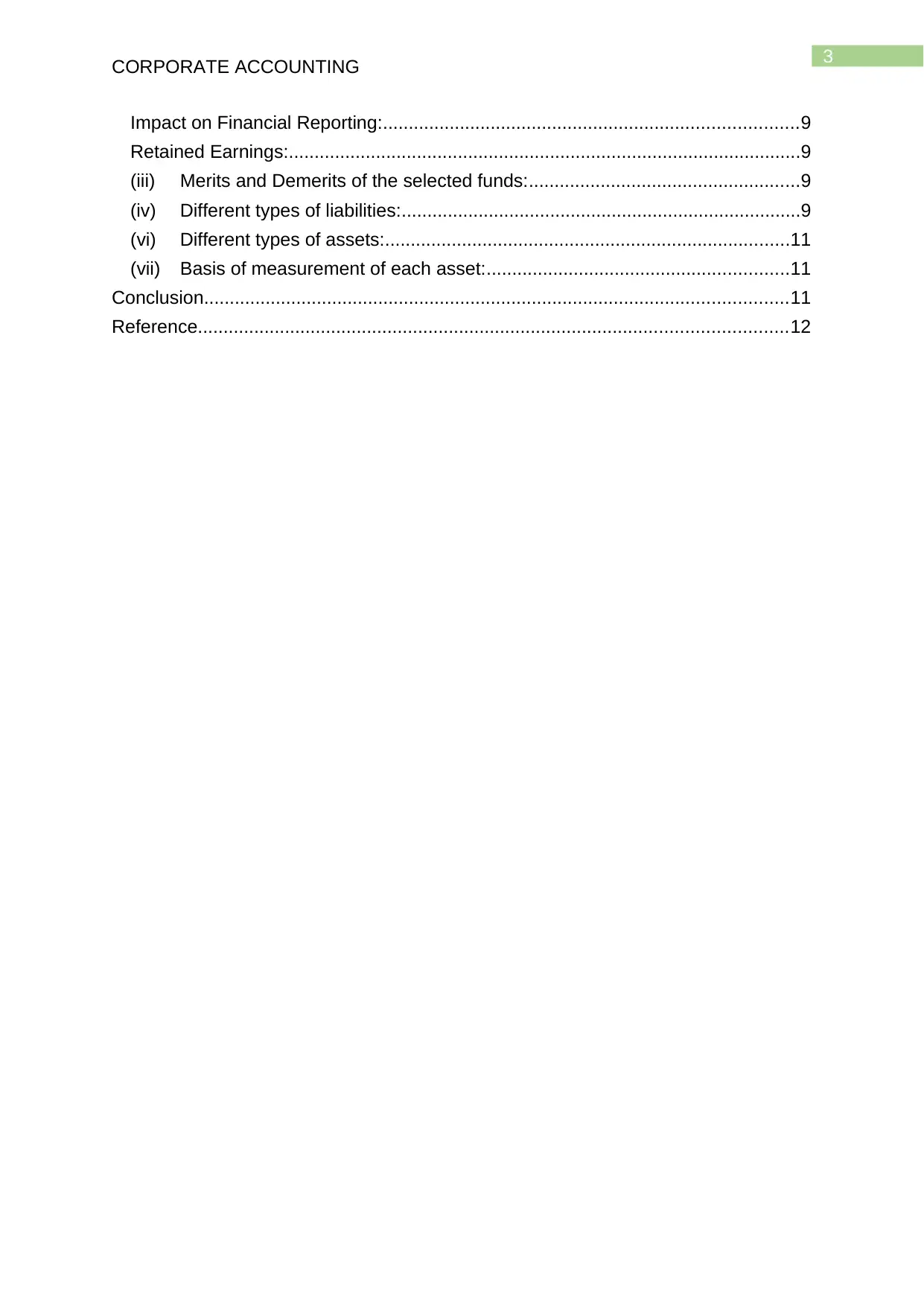
3
CORPORATE ACCOUNTING
Impact on Financial Reporting:.................................................................................9
Retained Earnings:....................................................................................................9
(iii) Merits and Demerits of the selected funds:.....................................................9
(iv) Different types of liabilities:..............................................................................9
(vi) Different types of assets:...............................................................................11
(vii) Basis of measurement of each asset:...........................................................11
Conclusion..................................................................................................................11
Reference...................................................................................................................12
CORPORATE ACCOUNTING
Impact on Financial Reporting:.................................................................................9
Retained Earnings:....................................................................................................9
(iii) Merits and Demerits of the selected funds:.....................................................9
(iv) Different types of liabilities:..............................................................................9
(vi) Different types of assets:...............................................................................11
(vii) Basis of measurement of each asset:...........................................................11
Conclusion..................................................................................................................11
Reference...................................................................................................................12
Secure Best Marks with AI Grader
Need help grading? Try our AI Grader for instant feedback on your assignments.
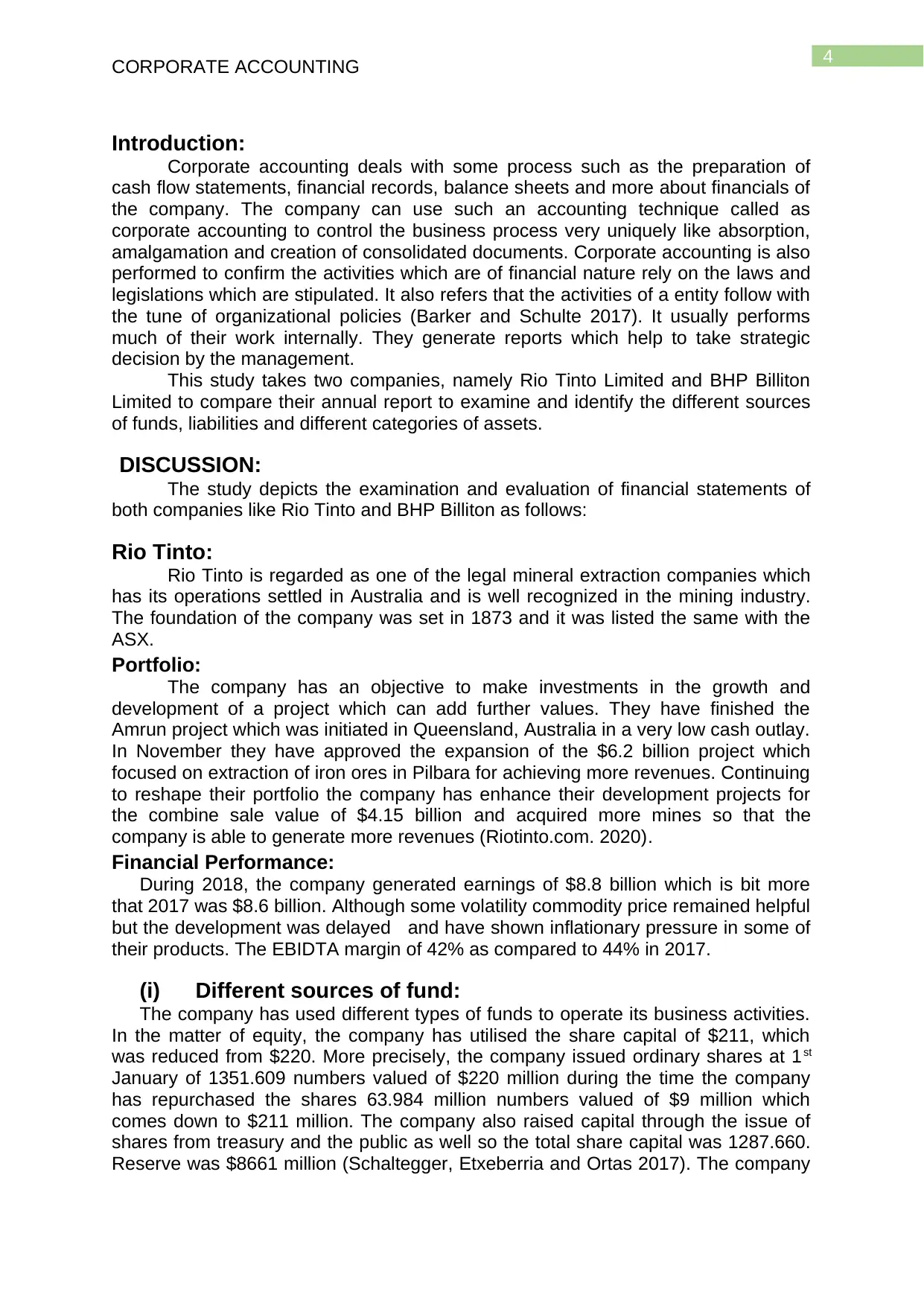
4
CORPORATE ACCOUNTING
Introduction:
Corporate accounting deals with some process such as the preparation of
cash flow statements, financial records, balance sheets and more about financials of
the company. The company can use such an accounting technique called as
corporate accounting to control the business process very uniquely like absorption,
amalgamation and creation of consolidated documents. Corporate accounting is also
performed to confirm the activities which are of financial nature rely on the laws and
legislations which are stipulated. It also refers that the activities of a entity follow with
the tune of organizational policies (Barker and Schulte 2017). It usually performs
much of their work internally. They generate reports which help to take strategic
decision by the management.
This study takes two companies, namely Rio Tinto Limited and BHP Billiton
Limited to compare their annual report to examine and identify the different sources
of funds, liabilities and different categories of assets.
DISCUSSION:
The study depicts the examination and evaluation of financial statements of
both companies like Rio Tinto and BHP Billiton as follows:
Rio Tinto:
Rio Tinto is regarded as one of the legal mineral extraction companies which
has its operations settled in Australia and is well recognized in the mining industry.
The foundation of the company was set in 1873 and it was listed the same with the
ASX.
Portfolio:
The company has an objective to make investments in the growth and
development of a project which can add further values. They have finished the
Amrun project which was initiated in Queensland, Australia in a very low cash outlay.
In November they have approved the expansion of the $6.2 billion project which
focused on extraction of iron ores in Pilbara for achieving more revenues. Continuing
to reshape their portfolio the company has enhance their development projects for
the combine sale value of $4.15 billion and acquired more mines so that the
company is able to generate more revenues (Riotinto.com. 2020).
Financial Performance:
During 2018, the company generated earnings of $8.8 billion which is bit more
that 2017 was $8.6 billion. Although some volatility commodity price remained helpful
but the development was delayed and have shown inflationary pressure in some of
their products. The EBIDTA margin of 42% as compared to 44% in 2017.
(i) Different sources of fund:
The company has used different types of funds to operate its business activities.
In the matter of equity, the company has utilised the share capital of $211, which
was reduced from $220. More precisely, the company issued ordinary shares at 1st
January of 1351.609 numbers valued of $220 million during the time the company
has repurchased the shares 63.984 million numbers valued of $9 million which
comes down to $211 million. The company also raised capital through the issue of
shares from treasury and the public as well so the total share capital was 1287.660.
Reserve was $8661 million (Schaltegger, Etxeberria and Ortas 2017). The company
CORPORATE ACCOUNTING
Introduction:
Corporate accounting deals with some process such as the preparation of
cash flow statements, financial records, balance sheets and more about financials of
the company. The company can use such an accounting technique called as
corporate accounting to control the business process very uniquely like absorption,
amalgamation and creation of consolidated documents. Corporate accounting is also
performed to confirm the activities which are of financial nature rely on the laws and
legislations which are stipulated. It also refers that the activities of a entity follow with
the tune of organizational policies (Barker and Schulte 2017). It usually performs
much of their work internally. They generate reports which help to take strategic
decision by the management.
This study takes two companies, namely Rio Tinto Limited and BHP Billiton
Limited to compare their annual report to examine and identify the different sources
of funds, liabilities and different categories of assets.
DISCUSSION:
The study depicts the examination and evaluation of financial statements of
both companies like Rio Tinto and BHP Billiton as follows:
Rio Tinto:
Rio Tinto is regarded as one of the legal mineral extraction companies which
has its operations settled in Australia and is well recognized in the mining industry.
The foundation of the company was set in 1873 and it was listed the same with the
ASX.
Portfolio:
The company has an objective to make investments in the growth and
development of a project which can add further values. They have finished the
Amrun project which was initiated in Queensland, Australia in a very low cash outlay.
In November they have approved the expansion of the $6.2 billion project which
focused on extraction of iron ores in Pilbara for achieving more revenues. Continuing
to reshape their portfolio the company has enhance their development projects for
the combine sale value of $4.15 billion and acquired more mines so that the
company is able to generate more revenues (Riotinto.com. 2020).
Financial Performance:
During 2018, the company generated earnings of $8.8 billion which is bit more
that 2017 was $8.6 billion. Although some volatility commodity price remained helpful
but the development was delayed and have shown inflationary pressure in some of
their products. The EBIDTA margin of 42% as compared to 44% in 2017.
(i) Different sources of fund:
The company has used different types of funds to operate its business activities.
In the matter of equity, the company has utilised the share capital of $211, which
was reduced from $220. More precisely, the company issued ordinary shares at 1st
January of 1351.609 numbers valued of $220 million during the time the company
has repurchased the shares 63.984 million numbers valued of $9 million which
comes down to $211 million. The company also raised capital through the issue of
shares from treasury and the public as well so the total share capital was 1287.660.
Reserve was $8661 million (Schaltegger, Etxeberria and Ortas 2017). The company
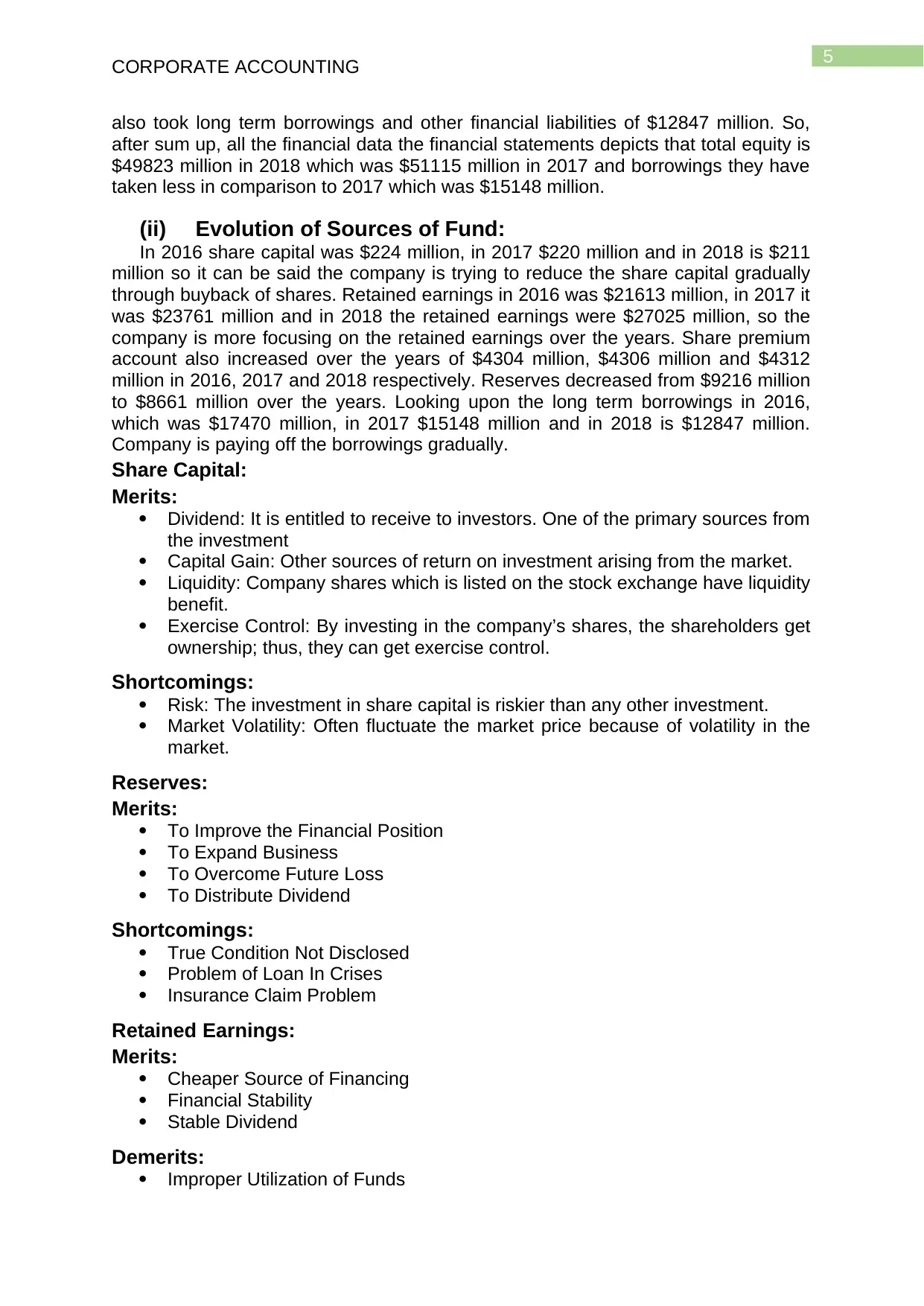
5
CORPORATE ACCOUNTING
also took long term borrowings and other financial liabilities of $12847 million. So,
after sum up, all the financial data the financial statements depicts that total equity is
$49823 million in 2018 which was $51115 million in 2017 and borrowings they have
taken less in comparison to 2017 which was $15148 million.
(ii) Evolution of Sources of Fund:
In 2016 share capital was $224 million, in 2017 $220 million and in 2018 is $211
million so it can be said the company is trying to reduce the share capital gradually
through buyback of shares. Retained earnings in 2016 was $21613 million, in 2017 it
was $23761 million and in 2018 the retained earnings were $27025 million, so the
company is more focusing on the retained earnings over the years. Share premium
account also increased over the years of $4304 million, $4306 million and $4312
million in 2016, 2017 and 2018 respectively. Reserves decreased from $9216 million
to $8661 million over the years. Looking upon the long term borrowings in 2016,
which was $17470 million, in 2017 $15148 million and in 2018 is $12847 million.
Company is paying off the borrowings gradually.
Share Capital:
Merits:
Dividend: It is entitled to receive to investors. One of the primary sources from
the investment
Capital Gain: Other sources of return on investment arising from the market.
Liquidity: Company shares which is listed on the stock exchange have liquidity
benefit.
Exercise Control: By investing in the company’s shares, the shareholders get
ownership; thus, they can get exercise control.
Shortcomings:
Risk: The investment in share capital is riskier than any other investment.
Market Volatility: Often fluctuate the market price because of volatility in the
market.
Reserves:
Merits:
To Improve the Financial Position
To Expand Business
To Overcome Future Loss
To Distribute Dividend
Shortcomings:
True Condition Not Disclosed
Problem of Loan In Crises
Insurance Claim Problem
Retained Earnings:
Merits:
Cheaper Source of Financing
Financial Stability
Stable Dividend
Demerits:
Improper Utilization of Funds
CORPORATE ACCOUNTING
also took long term borrowings and other financial liabilities of $12847 million. So,
after sum up, all the financial data the financial statements depicts that total equity is
$49823 million in 2018 which was $51115 million in 2017 and borrowings they have
taken less in comparison to 2017 which was $15148 million.
(ii) Evolution of Sources of Fund:
In 2016 share capital was $224 million, in 2017 $220 million and in 2018 is $211
million so it can be said the company is trying to reduce the share capital gradually
through buyback of shares. Retained earnings in 2016 was $21613 million, in 2017 it
was $23761 million and in 2018 the retained earnings were $27025 million, so the
company is more focusing on the retained earnings over the years. Share premium
account also increased over the years of $4304 million, $4306 million and $4312
million in 2016, 2017 and 2018 respectively. Reserves decreased from $9216 million
to $8661 million over the years. Looking upon the long term borrowings in 2016,
which was $17470 million, in 2017 $15148 million and in 2018 is $12847 million.
Company is paying off the borrowings gradually.
Share Capital:
Merits:
Dividend: It is entitled to receive to investors. One of the primary sources from
the investment
Capital Gain: Other sources of return on investment arising from the market.
Liquidity: Company shares which is listed on the stock exchange have liquidity
benefit.
Exercise Control: By investing in the company’s shares, the shareholders get
ownership; thus, they can get exercise control.
Shortcomings:
Risk: The investment in share capital is riskier than any other investment.
Market Volatility: Often fluctuate the market price because of volatility in the
market.
Reserves:
Merits:
To Improve the Financial Position
To Expand Business
To Overcome Future Loss
To Distribute Dividend
Shortcomings:
True Condition Not Disclosed
Problem of Loan In Crises
Insurance Claim Problem
Retained Earnings:
Merits:
Cheaper Source of Financing
Financial Stability
Stable Dividend
Demerits:
Improper Utilization of Funds
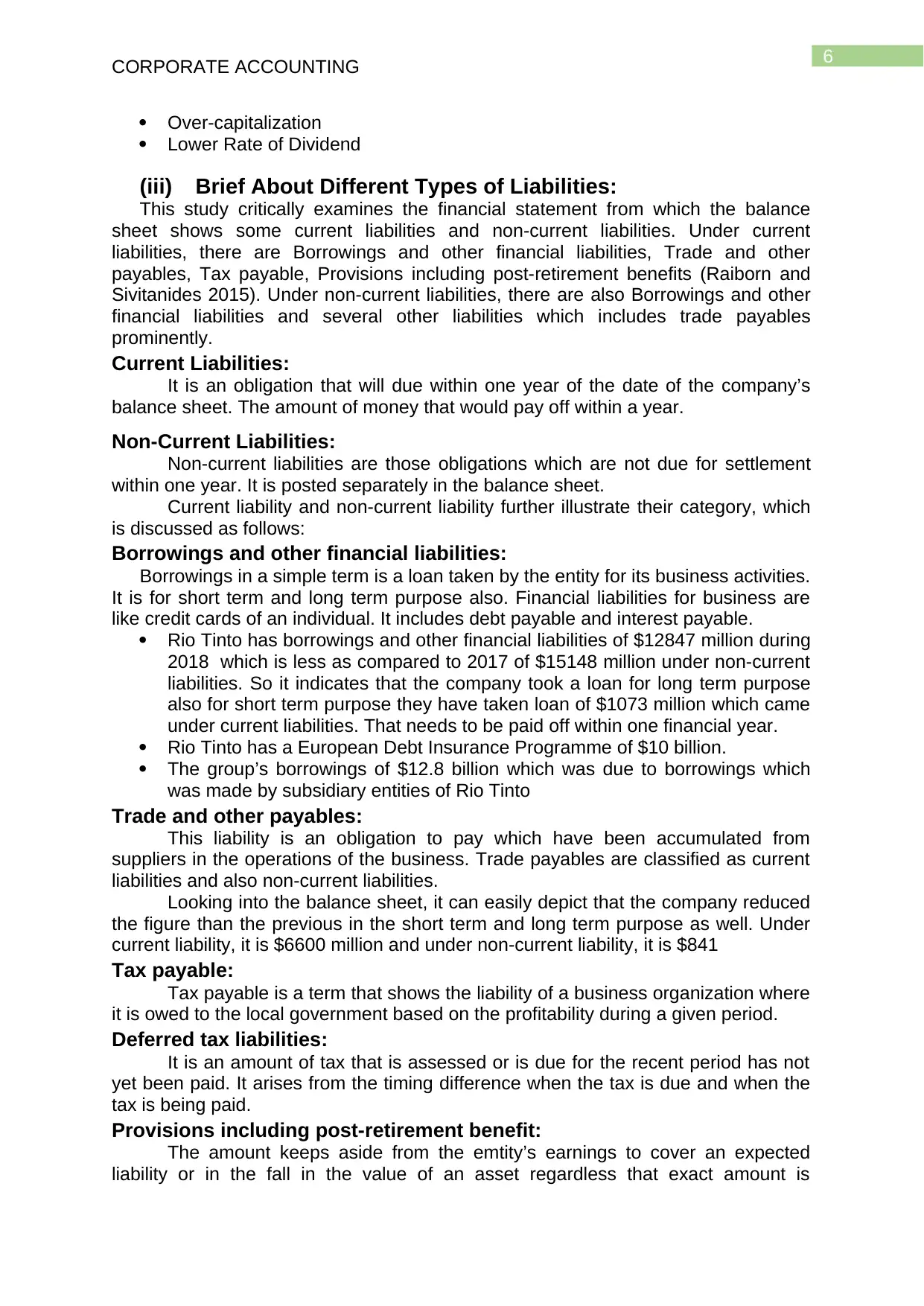
6
CORPORATE ACCOUNTING
Over-capitalization
Lower Rate of Dividend
(iii) Brief About Different Types of Liabilities:
This study critically examines the financial statement from which the balance
sheet shows some current liabilities and non-current liabilities. Under current
liabilities, there are Borrowings and other financial liabilities, Trade and other
payables, Tax payable, Provisions including post-retirement benefits (Raiborn and
Sivitanides 2015). Under non-current liabilities, there are also Borrowings and other
financial liabilities and several other liabilities which includes trade payables
prominently.
Current Liabilities:
It is an obligation that will due within one year of the date of the company’s
balance sheet. The amount of money that would pay off within a year.
Non-Current Liabilities:
Non-current liabilities are those obligations which are not due for settlement
within one year. It is posted separately in the balance sheet.
Current liability and non-current liability further illustrate their category, which
is discussed as follows:
Borrowings and other financial liabilities:
Borrowings in a simple term is a loan taken by the entity for its business activities.
It is for short term and long term purpose also. Financial liabilities for business are
like credit cards of an individual. It includes debt payable and interest payable.
Rio Tinto has borrowings and other financial liabilities of $12847 million during
2018 which is less as compared to 2017 of $15148 million under non-current
liabilities. So it indicates that the company took a loan for long term purpose
also for short term purpose they have taken loan of $1073 million which came
under current liabilities. That needs to be paid off within one financial year.
Rio Tinto has a European Debt Insurance Programme of $10 billion.
The group’s borrowings of $12.8 billion which was due to borrowings which
was made by subsidiary entities of Rio Tinto
Trade and other payables:
This liability is an obligation to pay which have been accumulated from
suppliers in the operations of the business. Trade payables are classified as current
liabilities and also non-current liabilities.
Looking into the balance sheet, it can easily depict that the company reduced
the figure than the previous in the short term and long term purpose as well. Under
current liability, it is $6600 million and under non-current liability, it is $841
Tax payable:
Tax payable is a term that shows the liability of a business organization where
it is owed to the local government based on the profitability during a given period.
Deferred tax liabilities:
It is an amount of tax that is assessed or is due for the recent period has not
yet been paid. It arises from the timing difference when the tax is due and when the
tax is being paid.
Provisions including post-retirement benefit:
The amount keeps aside from the emtity’s earnings to cover an expected
liability or in the fall in the value of an asset regardless that exact amount is
CORPORATE ACCOUNTING
Over-capitalization
Lower Rate of Dividend
(iii) Brief About Different Types of Liabilities:
This study critically examines the financial statement from which the balance
sheet shows some current liabilities and non-current liabilities. Under current
liabilities, there are Borrowings and other financial liabilities, Trade and other
payables, Tax payable, Provisions including post-retirement benefits (Raiborn and
Sivitanides 2015). Under non-current liabilities, there are also Borrowings and other
financial liabilities and several other liabilities which includes trade payables
prominently.
Current Liabilities:
It is an obligation that will due within one year of the date of the company’s
balance sheet. The amount of money that would pay off within a year.
Non-Current Liabilities:
Non-current liabilities are those obligations which are not due for settlement
within one year. It is posted separately in the balance sheet.
Current liability and non-current liability further illustrate their category, which
is discussed as follows:
Borrowings and other financial liabilities:
Borrowings in a simple term is a loan taken by the entity for its business activities.
It is for short term and long term purpose also. Financial liabilities for business are
like credit cards of an individual. It includes debt payable and interest payable.
Rio Tinto has borrowings and other financial liabilities of $12847 million during
2018 which is less as compared to 2017 of $15148 million under non-current
liabilities. So it indicates that the company took a loan for long term purpose
also for short term purpose they have taken loan of $1073 million which came
under current liabilities. That needs to be paid off within one financial year.
Rio Tinto has a European Debt Insurance Programme of $10 billion.
The group’s borrowings of $12.8 billion which was due to borrowings which
was made by subsidiary entities of Rio Tinto
Trade and other payables:
This liability is an obligation to pay which have been accumulated from
suppliers in the operations of the business. Trade payables are classified as current
liabilities and also non-current liabilities.
Looking into the balance sheet, it can easily depict that the company reduced
the figure than the previous in the short term and long term purpose as well. Under
current liability, it is $6600 million and under non-current liability, it is $841
Tax payable:
Tax payable is a term that shows the liability of a business organization where
it is owed to the local government based on the profitability during a given period.
Deferred tax liabilities:
It is an amount of tax that is assessed or is due for the recent period has not
yet been paid. It arises from the timing difference when the tax is due and when the
tax is being paid.
Provisions including post-retirement benefit:
The amount keeps aside from the emtity’s earnings to cover an expected
liability or in the fall in the value of an asset regardless that exact amount is
Paraphrase This Document
Need a fresh take? Get an instant paraphrase of this document with our AI Paraphraser
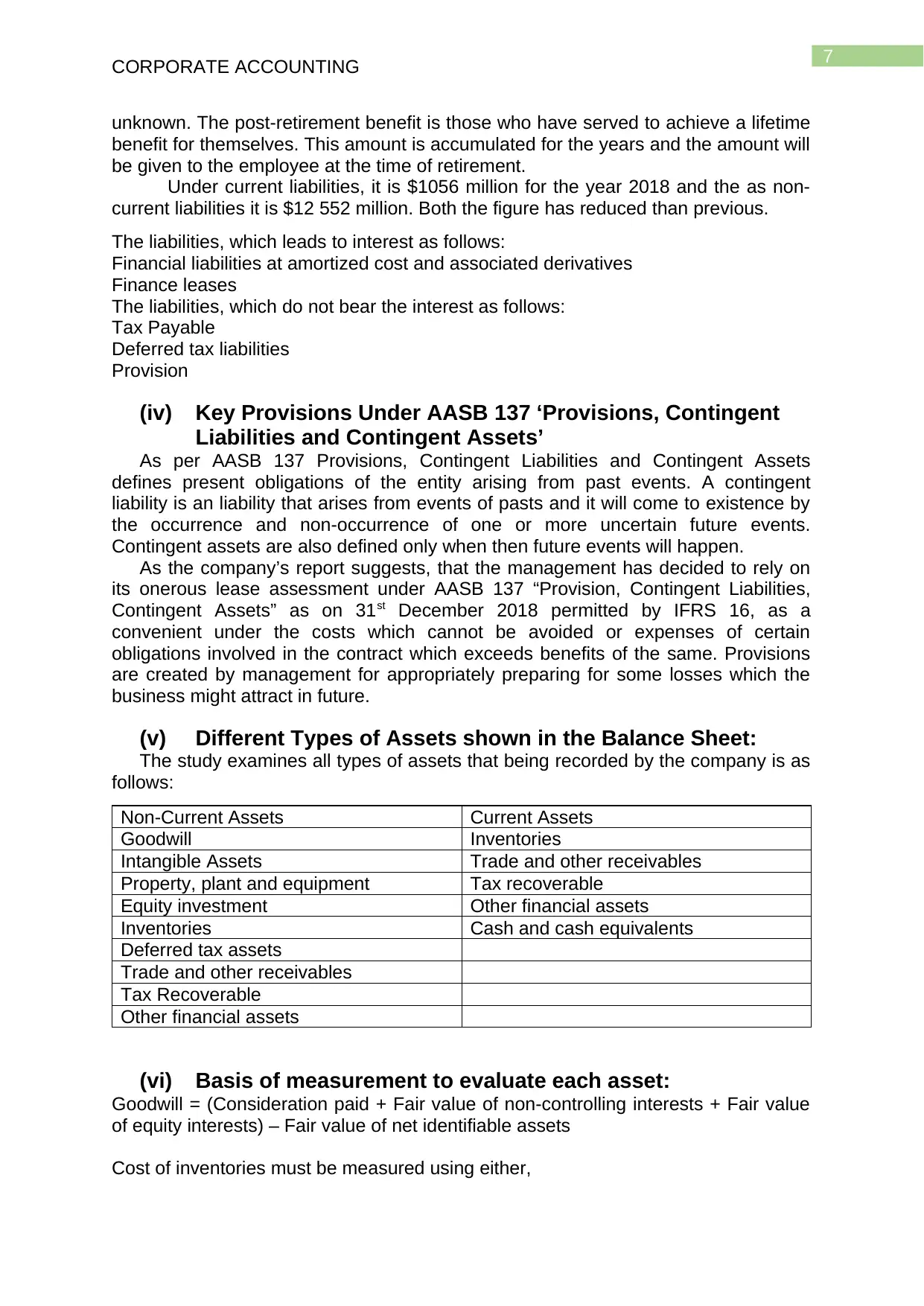
7
CORPORATE ACCOUNTING
unknown. The post-retirement benefit is those who have served to achieve a lifetime
benefit for themselves. This amount is accumulated for the years and the amount will
be given to the employee at the time of retirement.
Under current liabilities, it is $1056 million for the year 2018 and the as non-
current liabilities it is $12 552 million. Both the figure has reduced than previous.
The liabilities, which leads to interest as follows:
Financial liabilities at amortized cost and associated derivatives
Finance leases
The liabilities, which do not bear the interest as follows:
Tax Payable
Deferred tax liabilities
Provision
(iv) Key Provisions Under AASB 137 ‘Provisions, Contingent
Liabilities and Contingent Assets’
As per AASB 137 Provisions, Contingent Liabilities and Contingent Assets
defines present obligations of the entity arising from past events. A contingent
liability is an liability that arises from events of pasts and it will come to existence by
the occurrence and non-occurrence of one or more uncertain future events.
Contingent assets are also defined only when then future events will happen.
As the company’s report suggests, that the management has decided to rely on
its onerous lease assessment under AASB 137 “Provision, Contingent Liabilities,
Contingent Assets” as on 31st December 2018 permitted by IFRS 16, as a
convenient under the costs which cannot be avoided or expenses of certain
obligations involved in the contract which exceeds benefits of the same. Provisions
are created by management for appropriately preparing for some losses which the
business might attract in future.
(v) Different Types of Assets shown in the Balance Sheet:
The study examines all types of assets that being recorded by the company is as
follows:
Non-Current Assets Current Assets
Goodwill Inventories
Intangible Assets Trade and other receivables
Property, plant and equipment Tax recoverable
Equity investment Other financial assets
Inventories Cash and cash equivalents
Deferred tax assets
Trade and other receivables
Tax Recoverable
Other financial assets
(vi) Basis of measurement to evaluate each asset:
Goodwill = (Consideration paid + Fair value of non-controlling interests + Fair value
of equity interests) – Fair value of net identifiable assets
Cost of inventories must be measured using either,
CORPORATE ACCOUNTING
unknown. The post-retirement benefit is those who have served to achieve a lifetime
benefit for themselves. This amount is accumulated for the years and the amount will
be given to the employee at the time of retirement.
Under current liabilities, it is $1056 million for the year 2018 and the as non-
current liabilities it is $12 552 million. Both the figure has reduced than previous.
The liabilities, which leads to interest as follows:
Financial liabilities at amortized cost and associated derivatives
Finance leases
The liabilities, which do not bear the interest as follows:
Tax Payable
Deferred tax liabilities
Provision
(iv) Key Provisions Under AASB 137 ‘Provisions, Contingent
Liabilities and Contingent Assets’
As per AASB 137 Provisions, Contingent Liabilities and Contingent Assets
defines present obligations of the entity arising from past events. A contingent
liability is an liability that arises from events of pasts and it will come to existence by
the occurrence and non-occurrence of one or more uncertain future events.
Contingent assets are also defined only when then future events will happen.
As the company’s report suggests, that the management has decided to rely on
its onerous lease assessment under AASB 137 “Provision, Contingent Liabilities,
Contingent Assets” as on 31st December 2018 permitted by IFRS 16, as a
convenient under the costs which cannot be avoided or expenses of certain
obligations involved in the contract which exceeds benefits of the same. Provisions
are created by management for appropriately preparing for some losses which the
business might attract in future.
(v) Different Types of Assets shown in the Balance Sheet:
The study examines all types of assets that being recorded by the company is as
follows:
Non-Current Assets Current Assets
Goodwill Inventories
Intangible Assets Trade and other receivables
Property, plant and equipment Tax recoverable
Equity investment Other financial assets
Inventories Cash and cash equivalents
Deferred tax assets
Trade and other receivables
Tax Recoverable
Other financial assets
(vi) Basis of measurement to evaluate each asset:
Goodwill = (Consideration paid + Fair value of non-controlling interests + Fair value
of equity interests) – Fair value of net identifiable assets
Cost of inventories must be measured using either,
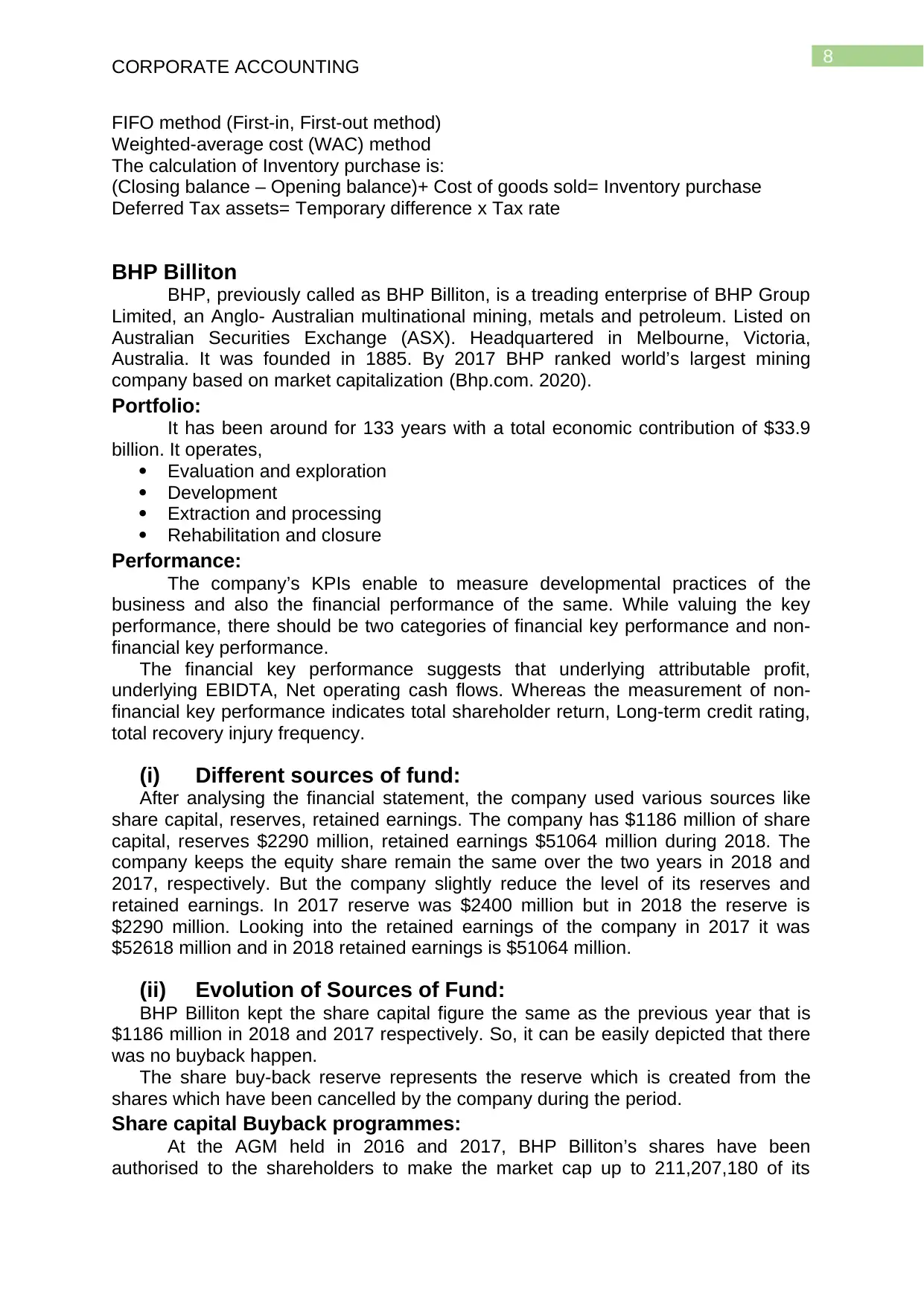
8
CORPORATE ACCOUNTING
FIFO method (First-in, First-out method)
Weighted-average cost (WAC) method
The calculation of Inventory purchase is:
(Closing balance – Opening balance)+ Cost of goods sold= Inventory purchase
Deferred Tax assets= Temporary difference x Tax rate
BHP Billiton
BHP, previously called as BHP Billiton, is a treading enterprise of BHP Group
Limited, an Anglo- Australian multinational mining, metals and petroleum. Listed on
Australian Securities Exchange (ASX). Headquartered in Melbourne, Victoria,
Australia. It was founded in 1885. By 2017 BHP ranked world’s largest mining
company based on market capitalization (Bhp.com. 2020).
Portfolio:
It has been around for 133 years with a total economic contribution of $33.9
billion. It operates,
Evaluation and exploration
Development
Extraction and processing
Rehabilitation and closure
Performance:
The company’s KPIs enable to measure developmental practices of the
business and also the financial performance of the same. While valuing the key
performance, there should be two categories of financial key performance and non-
financial key performance.
The financial key performance suggests that underlying attributable profit,
underlying EBIDTA, Net operating cash flows. Whereas the measurement of non-
financial key performance indicates total shareholder return, Long-term credit rating,
total recovery injury frequency.
(i) Different sources of fund:
After analysing the financial statement, the company used various sources like
share capital, reserves, retained earnings. The company has $1186 million of share
capital, reserves $2290 million, retained earnings $51064 million during 2018. The
company keeps the equity share remain the same over the two years in 2018 and
2017, respectively. But the company slightly reduce the level of its reserves and
retained earnings. In 2017 reserve was $2400 million but in 2018 the reserve is
$2290 million. Looking into the retained earnings of the company in 2017 it was
$52618 million and in 2018 retained earnings is $51064 million.
(ii) Evolution of Sources of Fund:
BHP Billiton kept the share capital figure the same as the previous year that is
$1186 million in 2018 and 2017 respectively. So, it can be easily depicted that there
was no buyback happen.
The share buy-back reserve represents the reserve which is created from the
shares which have been cancelled by the company during the period.
Share capital Buyback programmes:
At the AGM held in 2016 and 2017, BHP Billiton’s shares have been
authorised to the shareholders to make the market cap up to 211,207,180 of its
CORPORATE ACCOUNTING
FIFO method (First-in, First-out method)
Weighted-average cost (WAC) method
The calculation of Inventory purchase is:
(Closing balance – Opening balance)+ Cost of goods sold= Inventory purchase
Deferred Tax assets= Temporary difference x Tax rate
BHP Billiton
BHP, previously called as BHP Billiton, is a treading enterprise of BHP Group
Limited, an Anglo- Australian multinational mining, metals and petroleum. Listed on
Australian Securities Exchange (ASX). Headquartered in Melbourne, Victoria,
Australia. It was founded in 1885. By 2017 BHP ranked world’s largest mining
company based on market capitalization (Bhp.com. 2020).
Portfolio:
It has been around for 133 years with a total economic contribution of $33.9
billion. It operates,
Evaluation and exploration
Development
Extraction and processing
Rehabilitation and closure
Performance:
The company’s KPIs enable to measure developmental practices of the
business and also the financial performance of the same. While valuing the key
performance, there should be two categories of financial key performance and non-
financial key performance.
The financial key performance suggests that underlying attributable profit,
underlying EBIDTA, Net operating cash flows. Whereas the measurement of non-
financial key performance indicates total shareholder return, Long-term credit rating,
total recovery injury frequency.
(i) Different sources of fund:
After analysing the financial statement, the company used various sources like
share capital, reserves, retained earnings. The company has $1186 million of share
capital, reserves $2290 million, retained earnings $51064 million during 2018. The
company keeps the equity share remain the same over the two years in 2018 and
2017, respectively. But the company slightly reduce the level of its reserves and
retained earnings. In 2017 reserve was $2400 million but in 2018 the reserve is
$2290 million. Looking into the retained earnings of the company in 2017 it was
$52618 million and in 2018 retained earnings is $51064 million.
(ii) Evolution of Sources of Fund:
BHP Billiton kept the share capital figure the same as the previous year that is
$1186 million in 2018 and 2017 respectively. So, it can be easily depicted that there
was no buyback happen.
The share buy-back reserve represents the reserve which is created from the
shares which have been cancelled by the company during the period.
Share capital Buyback programmes:
At the AGM held in 2016 and 2017, BHP Billiton’s shares have been
authorised to the shareholders to make the market cap up to 211,207,180 of its
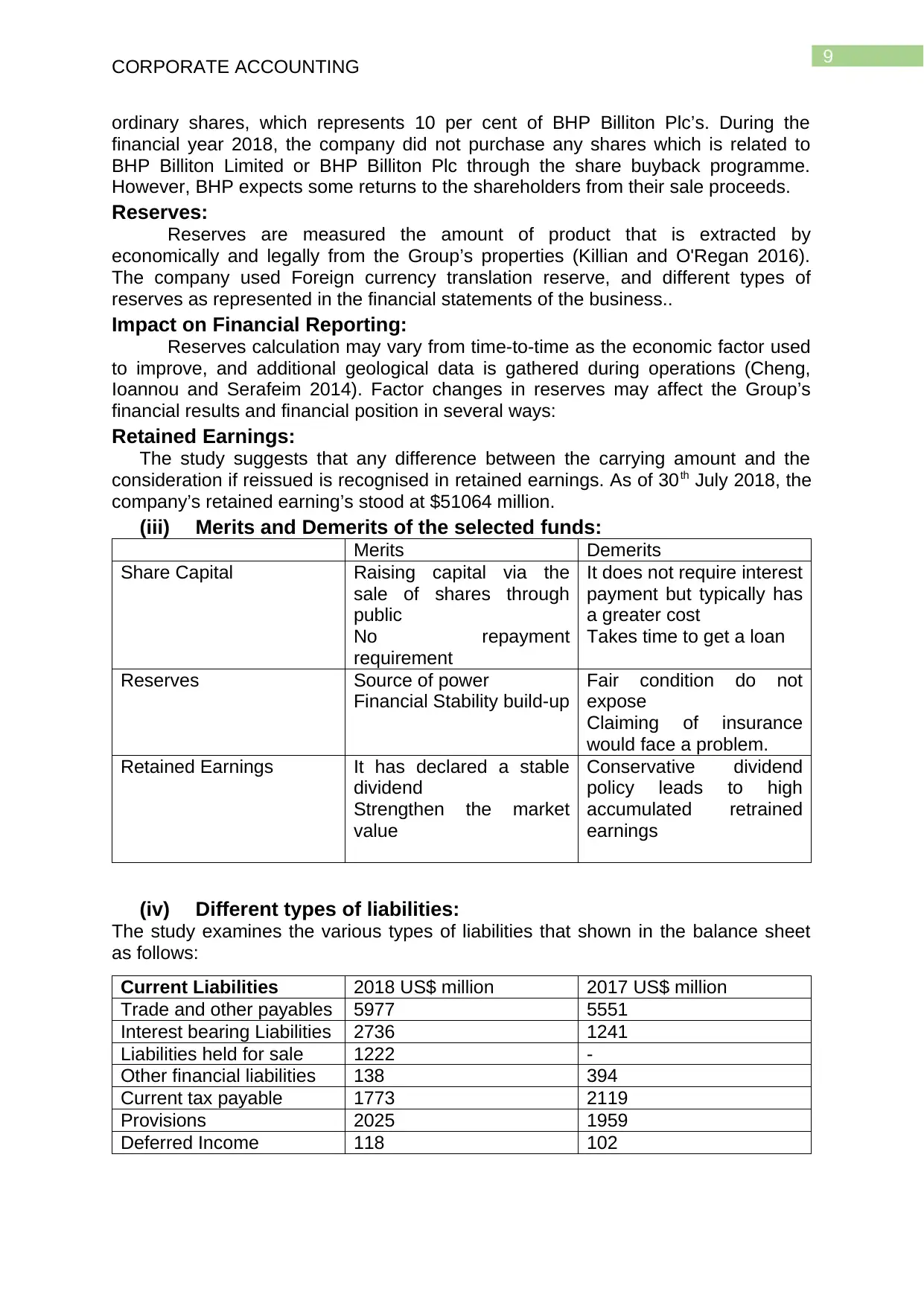
9
CORPORATE ACCOUNTING
ordinary shares, which represents 10 per cent of BHP Billiton Plc’s. During the
financial year 2018, the company did not purchase any shares which is related to
BHP Billiton Limited or BHP Billiton Plc through the share buyback programme.
However, BHP expects some returns to the shareholders from their sale proceeds.
Reserves:
Reserves are measured the amount of product that is extracted by
economically and legally from the Group’s properties (Killian and O'Regan 2016).
The company used Foreign currency translation reserve, and different types of
reserves as represented in the financial statements of the business..
Impact on Financial Reporting:
Reserves calculation may vary from time-to-time as the economic factor used
to improve, and additional geological data is gathered during operations (Cheng,
Ioannou and Serafeim 2014). Factor changes in reserves may affect the Group’s
financial results and financial position in several ways:
Retained Earnings:
The study suggests that any difference between the carrying amount and the
consideration if reissued is recognised in retained earnings. As of 30th July 2018, the
company’s retained earning’s stood at $51064 million.
(iii) Merits and Demerits of the selected funds:
Merits Demerits
Share Capital Raising capital via the
sale of shares through
public
No repayment
requirement
It does not require interest
payment but typically has
a greater cost
Takes time to get a loan
Reserves Source of power
Financial Stability build-up
Fair condition do not
expose
Claiming of insurance
would face a problem.
Retained Earnings It has declared a stable
dividend
Strengthen the market
value
Conservative dividend
policy leads to high
accumulated retrained
earnings
(iv) Different types of liabilities:
The study examines the various types of liabilities that shown in the balance sheet
as follows:
Current Liabilities 2018 US$ million 2017 US$ million
Trade and other payables 5977 5551
Interest bearing Liabilities 2736 1241
Liabilities held for sale 1222 -
Other financial liabilities 138 394
Current tax payable 1773 2119
Provisions 2025 1959
Deferred Income 118 102
CORPORATE ACCOUNTING
ordinary shares, which represents 10 per cent of BHP Billiton Plc’s. During the
financial year 2018, the company did not purchase any shares which is related to
BHP Billiton Limited or BHP Billiton Plc through the share buyback programme.
However, BHP expects some returns to the shareholders from their sale proceeds.
Reserves:
Reserves are measured the amount of product that is extracted by
economically and legally from the Group’s properties (Killian and O'Regan 2016).
The company used Foreign currency translation reserve, and different types of
reserves as represented in the financial statements of the business..
Impact on Financial Reporting:
Reserves calculation may vary from time-to-time as the economic factor used
to improve, and additional geological data is gathered during operations (Cheng,
Ioannou and Serafeim 2014). Factor changes in reserves may affect the Group’s
financial results and financial position in several ways:
Retained Earnings:
The study suggests that any difference between the carrying amount and the
consideration if reissued is recognised in retained earnings. As of 30th July 2018, the
company’s retained earning’s stood at $51064 million.
(iii) Merits and Demerits of the selected funds:
Merits Demerits
Share Capital Raising capital via the
sale of shares through
public
No repayment
requirement
It does not require interest
payment but typically has
a greater cost
Takes time to get a loan
Reserves Source of power
Financial Stability build-up
Fair condition do not
expose
Claiming of insurance
would face a problem.
Retained Earnings It has declared a stable
dividend
Strengthen the market
value
Conservative dividend
policy leads to high
accumulated retrained
earnings
(iv) Different types of liabilities:
The study examines the various types of liabilities that shown in the balance sheet
as follows:
Current Liabilities 2018 US$ million 2017 US$ million
Trade and other payables 5977 5551
Interest bearing Liabilities 2736 1241
Liabilities held for sale 1222 -
Other financial liabilities 138 394
Current tax payable 1773 2119
Provisions 2025 1959
Deferred Income 118 102
Secure Best Marks with AI Grader
Need help grading? Try our AI Grader for instant feedback on your assignments.
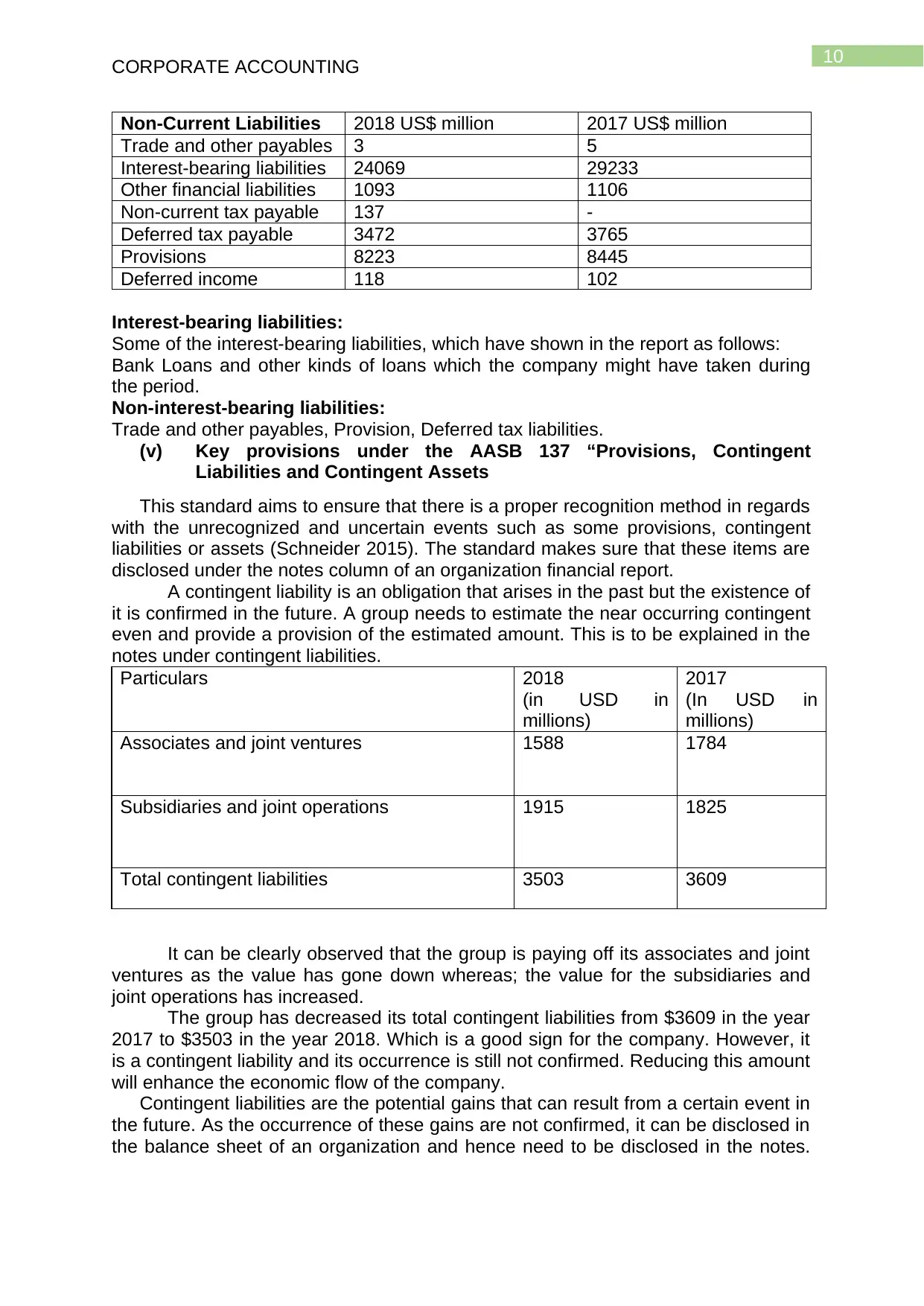
10
CORPORATE ACCOUNTING
Non-Current Liabilities 2018 US$ million 2017 US$ million
Trade and other payables 3 5
Interest-bearing liabilities 24069 29233
Other financial liabilities 1093 1106
Non-current tax payable 137 -
Deferred tax payable 3472 3765
Provisions 8223 8445
Deferred income 118 102
Interest-bearing liabilities:
Some of the interest-bearing liabilities, which have shown in the report as follows:
Bank Loans and other kinds of loans which the company might have taken during
the period.
Non-interest-bearing liabilities:
Trade and other payables, Provision, Deferred tax liabilities.
(v) Key provisions under the AASB 137 “Provisions, Contingent
Liabilities and Contingent Assets
This standard aims to ensure that there is a proper recognition method in regards
with the unrecognized and uncertain events such as some provisions, contingent
liabilities or assets (Schneider 2015). The standard makes sure that these items are
disclosed under the notes column of an organization financial report.
A contingent liability is an obligation that arises in the past but the existence of
it is confirmed in the future. A group needs to estimate the near occurring contingent
even and provide a provision of the estimated amount. This is to be explained in the
notes under contingent liabilities.
Particulars 2018
(in USD in
millions)
2017
(In USD in
millions)
Associates and joint ventures 1588 1784
Subsidiaries and joint operations 1915 1825
Total contingent liabilities 3503 3609
It can be clearly observed that the group is paying off its associates and joint
ventures as the value has gone down whereas; the value for the subsidiaries and
joint operations has increased.
The group has decreased its total contingent liabilities from $3609 in the year
2017 to $3503 in the year 2018. Which is a good sign for the company. However, it
is a contingent liability and its occurrence is still not confirmed. Reducing this amount
will enhance the economic flow of the company.
Contingent liabilities are the potential gains that can result from a certain event in
the future. As the occurrence of these gains are not confirmed, it can be disclosed in
the balance sheet of an organization and hence need to be disclosed in the notes.
CORPORATE ACCOUNTING
Non-Current Liabilities 2018 US$ million 2017 US$ million
Trade and other payables 3 5
Interest-bearing liabilities 24069 29233
Other financial liabilities 1093 1106
Non-current tax payable 137 -
Deferred tax payable 3472 3765
Provisions 8223 8445
Deferred income 118 102
Interest-bearing liabilities:
Some of the interest-bearing liabilities, which have shown in the report as follows:
Bank Loans and other kinds of loans which the company might have taken during
the period.
Non-interest-bearing liabilities:
Trade and other payables, Provision, Deferred tax liabilities.
(v) Key provisions under the AASB 137 “Provisions, Contingent
Liabilities and Contingent Assets
This standard aims to ensure that there is a proper recognition method in regards
with the unrecognized and uncertain events such as some provisions, contingent
liabilities or assets (Schneider 2015). The standard makes sure that these items are
disclosed under the notes column of an organization financial report.
A contingent liability is an obligation that arises in the past but the existence of
it is confirmed in the future. A group needs to estimate the near occurring contingent
even and provide a provision of the estimated amount. This is to be explained in the
notes under contingent liabilities.
Particulars 2018
(in USD in
millions)
2017
(In USD in
millions)
Associates and joint ventures 1588 1784
Subsidiaries and joint operations 1915 1825
Total contingent liabilities 3503 3609
It can be clearly observed that the group is paying off its associates and joint
ventures as the value has gone down whereas; the value for the subsidiaries and
joint operations has increased.
The group has decreased its total contingent liabilities from $3609 in the year
2017 to $3503 in the year 2018. Which is a good sign for the company. However, it
is a contingent liability and its occurrence is still not confirmed. Reducing this amount
will enhance the economic flow of the company.
Contingent liabilities are the potential gains that can result from a certain event in
the future. As the occurrence of these gains are not confirmed, it can be disclosed in
the balance sheet of an organization and hence need to be disclosed in the notes.
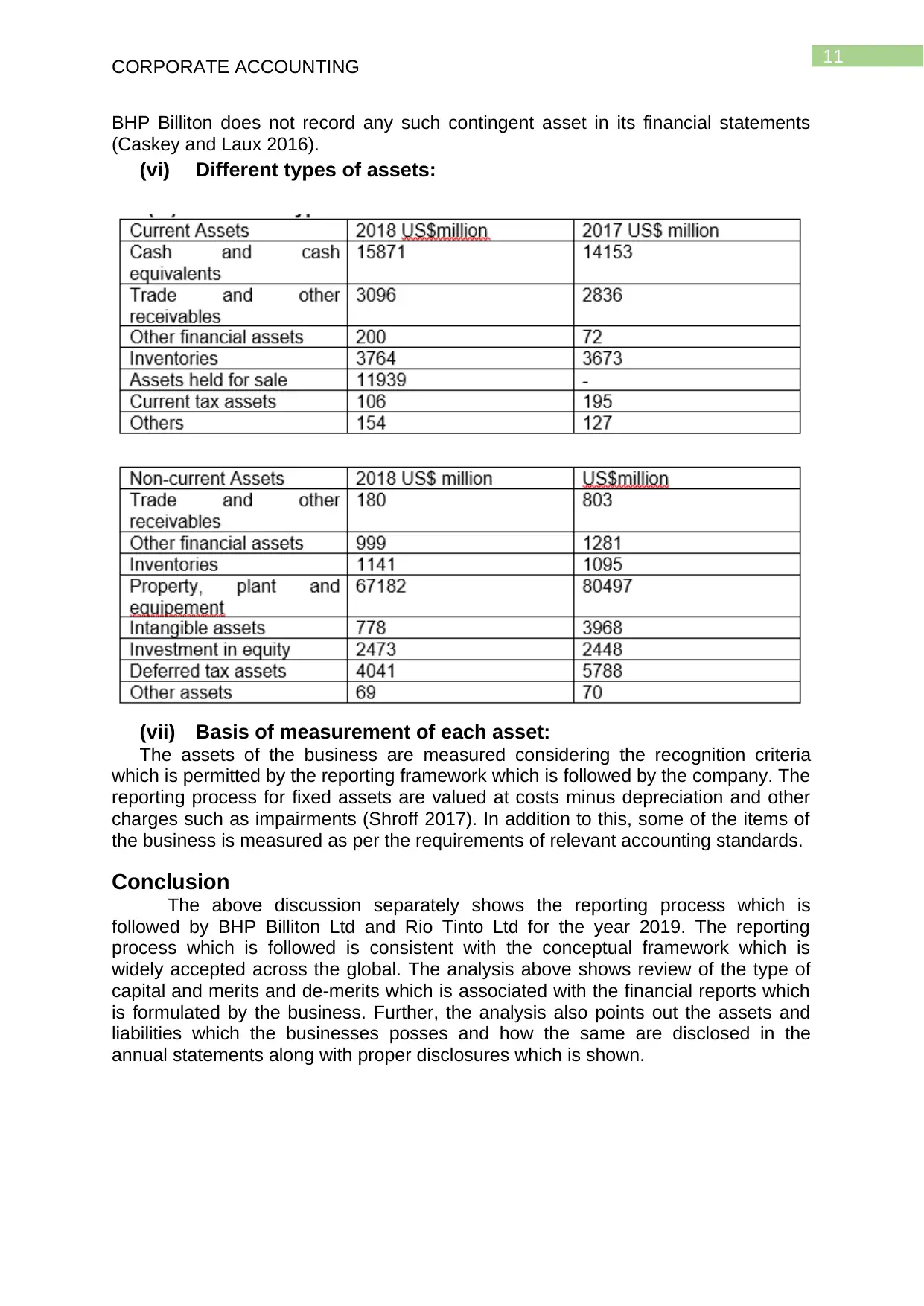
11
CORPORATE ACCOUNTING
BHP Billiton does not record any such contingent asset in its financial statements
(Caskey and Laux 2016).
(vi) Different types of assets:
(vii) Basis of measurement of each asset:
The assets of the business are measured considering the recognition criteria
which is permitted by the reporting framework which is followed by the company. The
reporting process for fixed assets are valued at costs minus depreciation and other
charges such as impairments (Shroff 2017). In addition to this, some of the items of
the business is measured as per the requirements of relevant accounting standards.
Conclusion
The above discussion separately shows the reporting process which is
followed by BHP Billiton Ltd and Rio Tinto Ltd for the year 2019. The reporting
process which is followed is consistent with the conceptual framework which is
widely accepted across the global. The analysis above shows review of the type of
capital and merits and de-merits which is associated with the financial reports which
is formulated by the business. Further, the analysis also points out the assets and
liabilities which the businesses posses and how the same are disclosed in the
annual statements along with proper disclosures which is shown.
CORPORATE ACCOUNTING
BHP Billiton does not record any such contingent asset in its financial statements
(Caskey and Laux 2016).
(vi) Different types of assets:
(vii) Basis of measurement of each asset:
The assets of the business are measured considering the recognition criteria
which is permitted by the reporting framework which is followed by the company. The
reporting process for fixed assets are valued at costs minus depreciation and other
charges such as impairments (Shroff 2017). In addition to this, some of the items of
the business is measured as per the requirements of relevant accounting standards.
Conclusion
The above discussion separately shows the reporting process which is
followed by BHP Billiton Ltd and Rio Tinto Ltd for the year 2019. The reporting
process which is followed is consistent with the conceptual framework which is
widely accepted across the global. The analysis above shows review of the type of
capital and merits and de-merits which is associated with the financial reports which
is formulated by the business. Further, the analysis also points out the assets and
liabilities which the businesses posses and how the same are disclosed in the
annual statements along with proper disclosures which is shown.
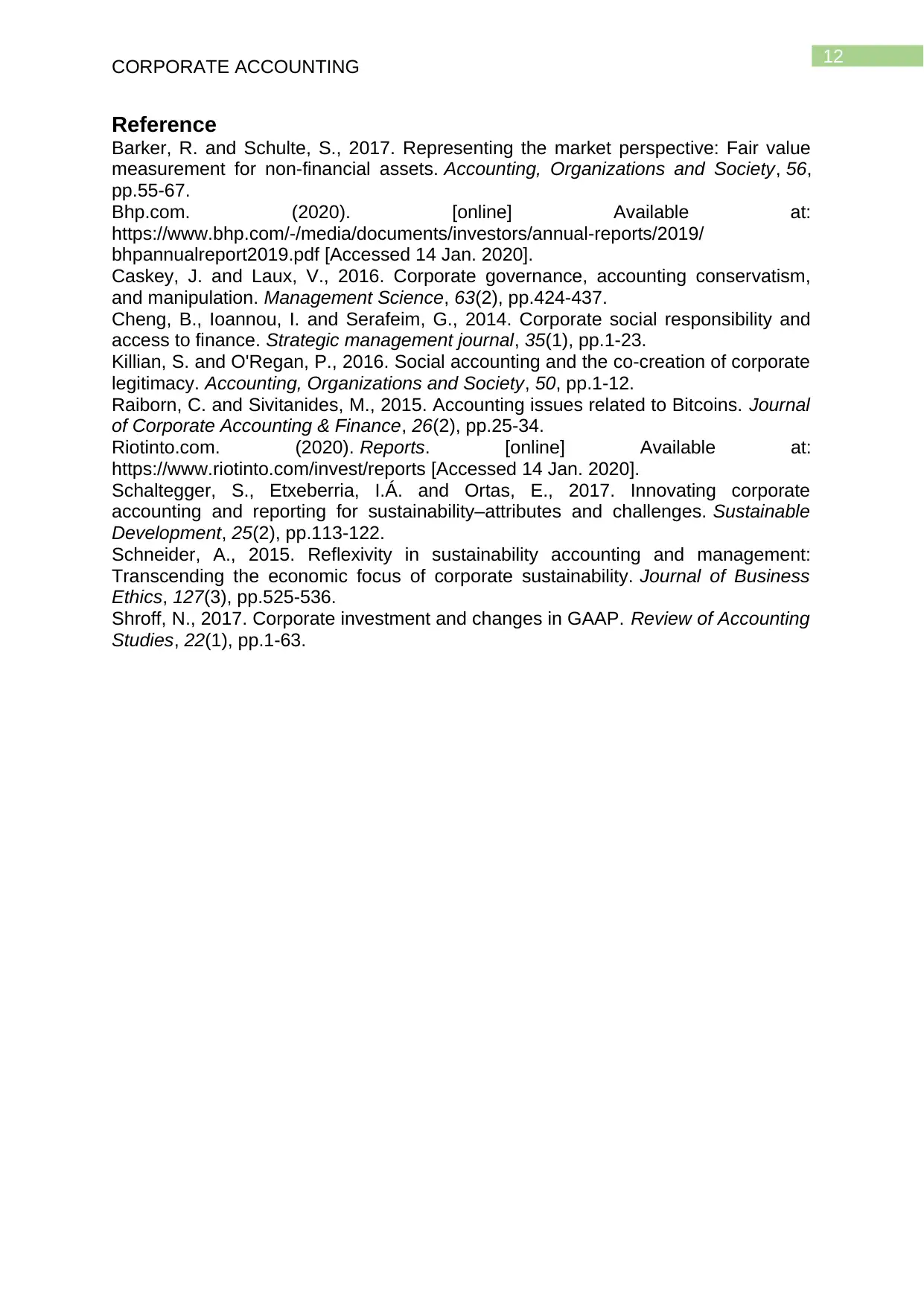
12
CORPORATE ACCOUNTING
Reference
Barker, R. and Schulte, S., 2017. Representing the market perspective: Fair value
measurement for non-financial assets. Accounting, Organizations and Society, 56,
pp.55-67.
Bhp.com. (2020). [online] Available at:
https://www.bhp.com/-/media/documents/investors/annual-reports/2019/
bhpannualreport2019.pdf [Accessed 14 Jan. 2020].
Caskey, J. and Laux, V., 2016. Corporate governance, accounting conservatism,
and manipulation. Management Science, 63(2), pp.424-437.
Cheng, B., Ioannou, I. and Serafeim, G., 2014. Corporate social responsibility and
access to finance. Strategic management journal, 35(1), pp.1-23.
Killian, S. and O'Regan, P., 2016. Social accounting and the co-creation of corporate
legitimacy. Accounting, Organizations and Society, 50, pp.1-12.
Raiborn, C. and Sivitanides, M., 2015. Accounting issues related to Bitcoins. Journal
of Corporate Accounting & Finance, 26(2), pp.25-34.
Riotinto.com. (2020). Reports. [online] Available at:
https://www.riotinto.com/invest/reports [Accessed 14 Jan. 2020].
Schaltegger, S., Etxeberria, I.Á. and Ortas, E., 2017. Innovating corporate
accounting and reporting for sustainability–attributes and challenges. Sustainable
Development, 25(2), pp.113-122.
Schneider, A., 2015. Reflexivity in sustainability accounting and management:
Transcending the economic focus of corporate sustainability. Journal of Business
Ethics, 127(3), pp.525-536.
Shroff, N., 2017. Corporate investment and changes in GAAP. Review of Accounting
Studies, 22(1), pp.1-63.
CORPORATE ACCOUNTING
Reference
Barker, R. and Schulte, S., 2017. Representing the market perspective: Fair value
measurement for non-financial assets. Accounting, Organizations and Society, 56,
pp.55-67.
Bhp.com. (2020). [online] Available at:
https://www.bhp.com/-/media/documents/investors/annual-reports/2019/
bhpannualreport2019.pdf [Accessed 14 Jan. 2020].
Caskey, J. and Laux, V., 2016. Corporate governance, accounting conservatism,
and manipulation. Management Science, 63(2), pp.424-437.
Cheng, B., Ioannou, I. and Serafeim, G., 2014. Corporate social responsibility and
access to finance. Strategic management journal, 35(1), pp.1-23.
Killian, S. and O'Regan, P., 2016. Social accounting and the co-creation of corporate
legitimacy. Accounting, Organizations and Society, 50, pp.1-12.
Raiborn, C. and Sivitanides, M., 2015. Accounting issues related to Bitcoins. Journal
of Corporate Accounting & Finance, 26(2), pp.25-34.
Riotinto.com. (2020). Reports. [online] Available at:
https://www.riotinto.com/invest/reports [Accessed 14 Jan. 2020].
Schaltegger, S., Etxeberria, I.Á. and Ortas, E., 2017. Innovating corporate
accounting and reporting for sustainability–attributes and challenges. Sustainable
Development, 25(2), pp.113-122.
Schneider, A., 2015. Reflexivity in sustainability accounting and management:
Transcending the economic focus of corporate sustainability. Journal of Business
Ethics, 127(3), pp.525-536.
Shroff, N., 2017. Corporate investment and changes in GAAP. Review of Accounting
Studies, 22(1), pp.1-63.
1 out of 13
Related Documents
Your All-in-One AI-Powered Toolkit for Academic Success.
+13062052269
info@desklib.com
Available 24*7 on WhatsApp / Email
![[object Object]](/_next/static/media/star-bottom.7253800d.svg)
Unlock your academic potential
© 2024 | Zucol Services PVT LTD | All rights reserved.





